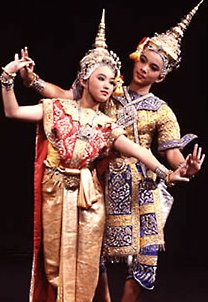Thai Dancing - Thailand
~
Wednesday, June 28, 2006


Thai Dancing:
The Thai Dance is a graceful and interpretative performance. It has played an indispensable part of Thai life from historical times to the present day. Thai dance is closely intertwined with the beliefs, traditions and customs of Thailand and is therefore important to the lives of the people. It has been kept alive through royal patronage in a continuous line of succession through the Sukhothai, Ayutthaya and Rattanakosin periods.
Thai dancing may be divided into two major styles: folk dance ('rabam phun muang') and classical dance ('natasin'). Each of the four regions of Thailand has its own folk dances that are usually associated with agricultural and social activities, such as rice planting, harvesting, festivals, and religious celebrations. Basically, northern folk dances are elegant and graceful while the dances of the South and Northeast are more active and fun-filled, but still retain the fundamental grace of Thai dancing in general. Central and eastern dances are clearly linked to the agrarian lifestyles of the people.
From the basic movements of folk dances, classical Thai dance further refined the elaborate hand gestures, arm and leg movements that are able to captivate audiences to this day.
Clasical Thai Dancing:
The history of Thai drama has generally been treated as a part of the study of Thai literature, culture and customs. The earliest literary references to Clasical Thai dancing appeared in the stone inscription of Phor Khun Ramkhamhaeng, the third king of the Sukhothai Kingdom.

0 comments:
Post a Comment